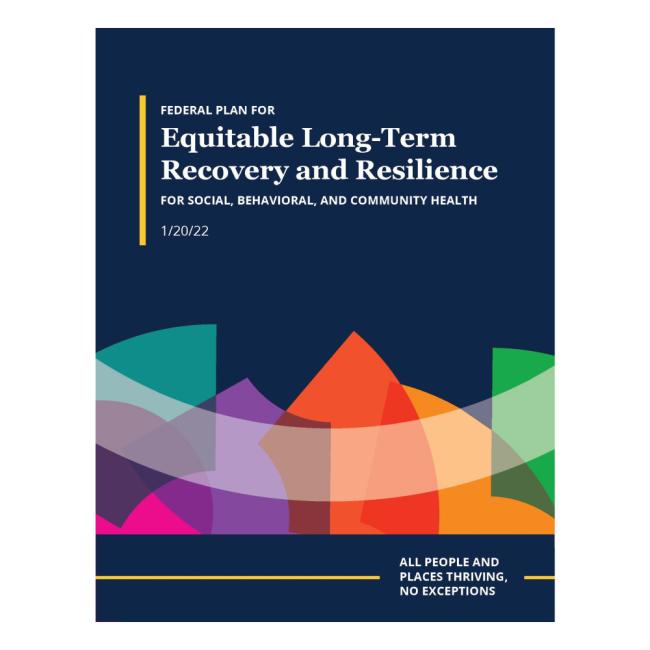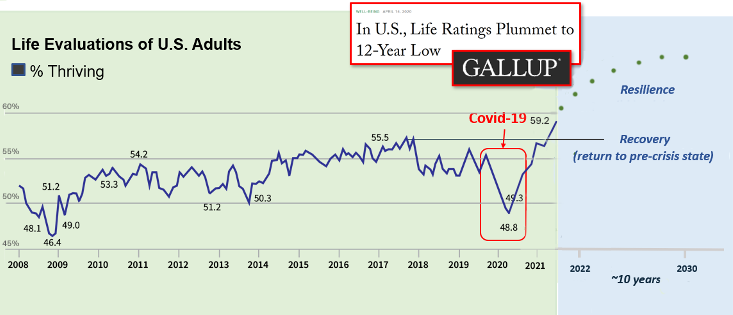The Federal Plan for Equitable Long-Term Recovery and Resilience (Federal Plan for ELTRR) lays out a government-wide approach for federal agencies to cooperatively strengthen the conditions necessary for improving individual and community resilience and well-being nationwide.

The Plan lays out a whole-of-government approach to improve long-term resilience.
What is the Plan’s purpose?
The Plan fosters a shared vision that advances a government-wide approach to support communities to build lasting resilience. It aims to align federal actions, outline recommendations federal departments can collaboratively implement to improve vital conditions, support community and individual empowerment to build resilience, and equitably improve health and well-being.
The Plan’s approach and recommendations are designed to be integrated and institutionalized into the normal and expected course of policymaking, operations, and funding across federal agencies. The goal is for all people and places to continuously thrive.

“The Federal Plan for Equitable Long-Term Recovery and Resilience gives me hope. We cannot effectively advance health outcomes and achieve health equity if we continue to work in siloed systems. Instead, we must expand beyond the health system. The Plan provides us that catalyst. It creates the critical skeleton upon which we can connect efforts — so we can synergize resources that allow us to achieve and sustain improvement so people and communities across the nation can thrive.”
Who is the Plan for?
The core audience for the Plan is federal government leaders and departments engaged in relevant work. Regional, state, and local public systems that form coalitions based on needs identified in the Plan may draw inspiration from the Plan and adapt its recommendations to bolster their work. Civil and cross-sector organizations may also use the Plan as inspiration for their own efforts to support well-being and resilience — and they can find actionable information and resources through the non-governmental organization Thriving Together.
Explore the Thriving Together Springboard
What are the Plan’s overarching principles?
The approach laid out in the Federal Plan for ELTRR calls for transformational systemic change in the federal government through the following principles:
- Empower communities to engage in equitable, self-driven discussions of needs and solutions
- Support equitable access to federal support and identify collaborative opportunities in partnership with communities using trauma-informed approaches and healing processes
- Redesign existing activities and develop new actions to address gaps and maximize outcomes
- Sustain cross-agency and cross-department collaborations and advancements that facilitate continuous investment and measurement of change
What type of actions does the Plan identify as key?
The Plan focuses on resources and actions that all federal departments and agencies can advance. Specifically, the Plan aims to:
- Align federal government departments and agencies to strengthen the Vital Conditions for Health and Well-Being
- Foster community-centered collaboration within and outside of government to ensure an equitable, thriving future
- Adapt steady-state and other federal investments within current agency authority to transform systems that enable resilience and well-being
- Achieve equity and aspire to eliminate disparities by focusing sustained resources on communities that have historically been marginalized or disadvantaged
Why does the Plan focus on resources across the federal government?
The Federal Plan for ELTRR intentionally focuses on leveraging opportunities across federal resources that are within existing authority and funding to advance the recommendations outlined in the Plan and associated actions. The recommendations allow departments and agencies to act on existing flexibilities across assets in more impactful and more efficient ways to advance long-term resilience.
The Federal Plan for ELTRR’s recommendations are meant to be integrated into the usual policymaking, operations, and funding across federal agencies. These recommendations should serve as a bedrock for continuously advancing and maintaining an effective and responsive government in service of communities and individuals — with a state of thriving for all as the shared goal. The Plan is directional and provides a framework and an actionable strategy for federal departments to collectively advance long-term resilience.

“At HUD, we understand the importance of linking arms with other federal agencies to improve upon the Vital Conditions for Health and Well-Being in our communities. And we know that the losses of the pandemic were not felt equally in our communities. This Plan represents an important framework to hold our government accountable to bridge all sectors to address housing, employment, transportation, and climate sustainability in a way that puts local needs at the forefront.”
How was the Plan developed?
By the spring of 2020, the COVID-19 pandemic had accelerated and exposed deeply entrenched disparities in health and well-being created by severe inequity across fragile systems. Specifically, many governing and community institutions weren’t prepared to meet increasing health, economic, and socio-emotional needs.
Explore resources demonstrating key disparities created by severe inequity across fragile systems
- The Federal Reserve's Response to COVID-19: Policy Issues — Congressional Resea…
- The Economic Impacts of COVID-19: Evidence from a New Public Database Built Us…
- Coronavirus Disease 2019 (COVID-19) and Diagnostic Error — Patient Safety Netwo…
- Economic Inequality: A Research Series — The Federal Reserve Bank of New York …
- NBER Studies Related to COVID-19 Pandemic By Topic Area — National Bureau of E…
- Pandemic precarity: COVID-19 is exposing and exacerbating inequalities in the A…
- Income and Income Inequality Are a Matter of Life and Death. What Can Policymak…
- Effect of socioeconomic inequalities and vulnerabilities on health-system prep…
The pandemic highlighted how far the nation was from being resilient, thriving, and equitable. Disparities in economic opportunity, overall health and well-being, and risks for disease and death had not only persisted but also increased, reinforced by systemic inequity over decades.
“The Council wishes to reiterate that longstanding and well-documented conditions affecting the nation's most vulnerable populations have placed them at higher risk in the current crisis, and the pandemic has brought into sharp focus the immediate and long-term extent of these risks.”
To address these problems, senior career professionals from a wide variety of federal agencies came together to create the Federal Plan for ELTRR. They shared a common belief: recovery to pre-pandemic conditions would be unacceptable. Instead, the goal should be to improve future resilience for the entire nation. This means better positioning public systems to evolve in ways that promote individual and community resilience as the primary outcome of policy, programs, and funding opportunities.
As a result, the Plan lays out an approach for intentionally and strategically bringing federal resources together to address under-resourced systems, reduce the need for urgent services, invest in long-term resilience, and increase individuals’ and communities’ ability to thrive.
